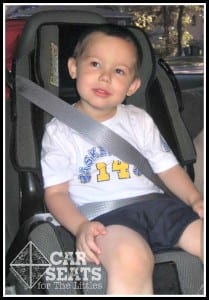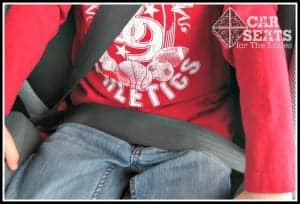Booster seats are deceptively easy. You just set them on the vehicle seat and go, right? The move to a booster seat is when we see caregivers cast aside many of the worries they had around their child’s harnessed car seats and just load the child into the booster seat, buckle, and go without checking the vehicle seat belt fit or training their child on how to sit properly. When a booster seat is used incorrectly, it can’t provide the proper protection in a crash. But when they’re properly, booster seats do a great job of protecting children in a crash.
The Insurance Institute for Highway Safety (IIHS) does a booster evaluation every year of Best Bets, Good Bets, Not Recommended, and those that need to Check Fit before use. Thankfully most seats are on the Best Bet list, which makes it easier on caregivers. This doesn’t mean all seats will fit all vehicles and all children; booster seats still need to be adjusted to fit the rider.
A booster seat should place the vehicle seat belt across the strongest points of the child’s body — across the hips and the center of the shoulder. While that seems simple enough, we find that caregivers struggle to adjust their child’s booster seat to fit them properly.
Here is an example of a now mostly-retired car seat that was notorious for its poor booster seat fit. Even though the child using the seat meets the requirements and is using it properly, it would not give proper protection in a crash. You can see the shoulder belt does not contact his shoulder, the lap belt is high on his abdomen and not touching his thighs, his bum is back, but even though he met the minimum requirements to use the seat, at 4 years old there is no way he would maintain this position the entire length of the trip. The belt fit is bad enough I would never recommend this seat be used as a booster.
When to Move to a Booster Seat
The first question to ask is when a child should move from their harnessed car seat into a booster seat? Once a child is at least 5 years old, meets the minimum height and weight requirements for the booster seat, and can sit properly in the seat 100% of the time, a booster seat is an appropriate restraint.
Our Harness or Booster article explains more.
When to Move from a Booster Seat
How long does a child need to use a booster seat? Longer than you think.
Children need booster seats until they can pass the Five Step Test. That’s when they’re around 10-12 years old, are at least 4 feet 9 inches tall, and are able to fit properly in an adult seat belt. Boosters are for Very Big Kids will go over the requirements to move out of a booster in more detail, as will Booster Seat Science.
Proper Booster Fit Guidelines
1. The shoulder belt should lie firmly in the middle of the child’s shoulder with shoulder belt guide just above the shoulder. The shoulder portion of the vehicle seat belt should be flush against the child’s body. A shoulder belt that doesn’t touch the person can’t properly restrain them.

For proper booster fit, backless boosters require head support to the top of the child’s ears at all times
2. If the child is riding in a backless booster, or if the high back booster requires it, be sure there is head support from a vehicle head restraint behind the child’s head to at least the tops of the child’s ears.
Many backless booster seats come equipped with a shoulder belt guide adjuster. This acts as the shoulder belt guide to ensure the shoulder belt is flush with and appropriately positioned above the shoulder. This adjuster is usually attached to the back of the booster seat so the shoulder belt will then be between the child and the vehicle seat. Some booster seats require their use — read your booster seat’s manual to see if it’s needed and how it should be used.
3. The lap portion of the vehicle seat belt is low on the child’s thighs, off the abdomen, and pulled tight.

For proper booster fit, a child’s bum needs to remain all the way back when seated properly in a booster
4. The child’s rear end is all the way back in the booster seat. The depth of booster can help with this. For example, taller kids may need deeper boosters while shorter children may have a better fit with a taller booster seat.

If the child cannot remain seated properly in their booster at all times, she will need to continue riding in a harnessed seat
5. The child can maintain this position 100% of the time without moving out of position during the ride. If this cannot be accomplished, then the child should ride in a harnessed car seat until they’re ready to sit properly for the entire ride.
Key Points
Here are a few things to remember:
- Your child must be mature enough to use a booster seat
- Your child must meet the minimum height and weight requirements for the booster seat
- Your child must be able to sit properly in the booster seat 100% of the time
- The booster seat fits both your vehicle and child correctly
- Adjust the booster seat’s headrest as the child grows




